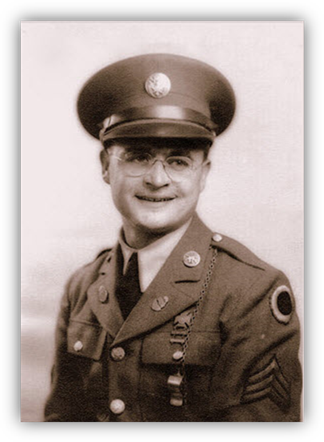GIVING DIRECTIONS
Unit Overview
In
this unit, students will learn about Deaf history, fingerspelling, vocabulary,
grammar and Deaf culture.
History

Rodger Wilton Young
Rodger Wilton Young was born April 28, 1918 in Tiffin, Ohio.
While he was born hearing, he was injured during a basketball game during
his high school years. The head injury affected both his hearing and eye sight.
Rodger dropped out of high school during his sophomore year because he could
not see or hear the teachers well.
In 1938, Rodger joined the National Guard and joined Company
B of the 148th Infantry Regiment. He worked his way up to rank of Sargeant. As
World War II was about to be underway, his unit was assigned to fight on New
Georgia. He made a good soldier, but due to his failing eye sight he took
a voluntary demotion before they arrived at their assignment. The commanding
officer wanted him to go to the hospital, but Rodger convinced him to allow him
to stay with Company B.
A week after they arrived in New Georgia, Rodger and a
twenty-man patrol encountered a Japanese ambush near Munda. For his bravery and
for sacrificing his life, Rodger Young was awarded the Medal of Honor. His
medal of honor read:
"Rank and organization: Private, U.S. Army, 148th
Infantry, 37th Infantry Division. Place and date: On New Georgia, Solomon
Islands, 31 July 1943. Entered service at: Clyde, Ohio. Birth: Tiffin, Ohio.
G.O. No.: 3, 6 January 1944. Citation: On 31 July 1943, the infantry company of
which Pvt. Young was a member, was ordered to make a limited withdrawal from
the battle line in order to adjust the battalion’s position for the night. At
this time, Pvt. Young’s platoon was engaged with the enemy in a dense jungle
where observation was very limited. The platoon suddenly was pinned down by
intense fire from a Japanese machine gun concealed on higher ground only 75
yards away. The initial burst wounded Pvt. Young. As the platoon started to
obey the order to withdraw, Pvt. Young called out that he could see the enemy
emplacement, whereupon he started creeping toward it. Another burst from the
machine gun wounded him the second time. Despite the wounds, he continued his
heroic advance, attracting enemy fire and answering with rifle fire. When he
was close enough to his objective, he began throwing hand grenades, and while
doing so was hit again and killed. Pvt. Young’s bold action in closing with
this Japanese pillbox and thus diverting its fire, permitted his platoon to
disengage itself, without loss, and was responsible for several enemy
casualties."
A composer by the name of Frank Loesser, was asked to write a
song honoring the common infantryman. The military gave him a list of privates'
names of soldiers who had been awarded the Medal of Honor. Loesser chose
Young because he had an "All American" sounding name. The choice
to use his name was a good one. Rodger Young overcame the adversity of his
handicaps to continue serving his country, and ultimately giving his life for
it.
To learn more about Rodger Wilton Young, visit the following
website:
http://the-american-catholic.com/2012/10/20/rodger-young/
 Now answer questions 1 through11.
Now answer questions 1 through11.
Fingerspelling
Go to the website asl.ms and practice for 20 minutes. When
you are finished, please type your score in the answer box for question 11.
 Now answer question 12.
Now answer question 12.
Go to the website asl.bz and practice for 20 minutes. When
you are finished, please type your answer in the answer box for question 12.
 Now answer question 13.
Now answer question 13.

Vocabulary
Grammar
When giving directions in ASL, it is important to be as
detailed as possible. You can begin by describing which direction the general
area is in. Is it north, south, east, or west? If you are describing how to get to
a location, be sure to describe which street to turn on and any landmarks that
help identify the area. It is also helpful to indicate whether a location is a
short distance or a long distance from the starting point. Because that people
tend to be more visual, it is important to give detailed and explicit
instructions as possible. The more information you can give the better.
 Now answer question 14.
Now answer question 14.
Culture
Lip
reading, also known as speech reading, is a technique of watching the lips and
facial movements to understand what the speaker is saying without hearing the
voice. Lip reading is a good tool when used in conjunction with other forms of
communication. However, it should be noted that only 30-40% of speech is
visible on the mouth. Many letters when spoken resemble each other. Similar
words can also be misunderstood for the other.
There
are a few things that can help improve lip reading. The lighting should be
adequate. If possible, the speaker should face the person they are speaking to
as much as possible. Don’t over exaggerate the words. Facial expressions should
also not be over exaggerated and as normal as possible. If a man has a mustache,
it is ideal for it to be thin. A thicker mustache is much harder to understand.
In the following video, you will be seeing a Disney clip that may appear to be bad lip reading. The sentences captioned in the video may appear as non-sense, but this is a reality for some people when lip reading is used. Remember that under best circumstances the lighting is good, the other person faces you directly and words are said naturally and not over enounced. Also remember, roughly 40% of speech is visible on the lips.
As you watch the video, note how the words seem to line up with what the person is saying, in addition to all the other distractions going on around the room. A person who is relying on lip reading may have a lot of miscommunications, or delay processing of the conversation as they try to make sense of it all.
 Now answer question 15.
Now answer question 15.